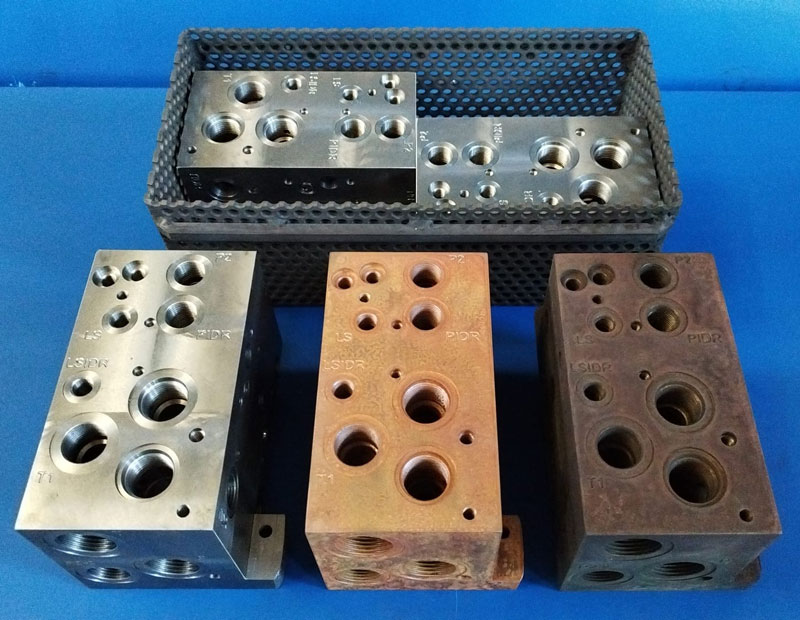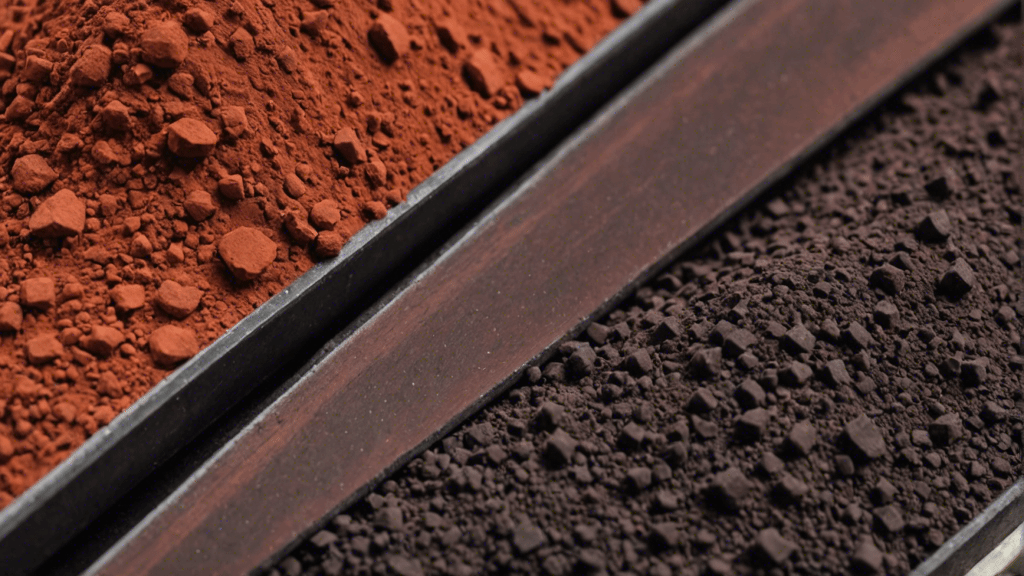Since thermal deburring is a thermochemical process based on the oxidation of material, I thought it might be useful to take a look at two different types of iron oxides, both of which can be formed as a result of the thermal deburring under certain process parameters.
Iron oxides are among the most important inorganic compounds used in a wide variety of industrial, scientific, and artistic applications. Two of the most well-known forms are red iron oxide (Fe₂O₃) and black iron oxide (Fe₃O₄). Though they are both oxides of iron, these compounds differ significantly in their chemical structure, physical properties, color, magnetic behavior, and production methods.
In this post im gonno talk about the following:
- Chemical Composition and Structure
- Physical and Optical Properties
- Magnetic Behavior
- Stability and Reactivity
- Applications
- Production Methods
- Summary Comparison Table
1. Chemical Composition and Structure
Red Iron Oxide (Fe₂O₃)
- Common Name: Hematite
- Oxidation State: Iron is in the +3 oxidation state (Fe³⁺)
- Crystal Structure: Trigonal (rhombohedral)
- Molecular Weight: 159.69 g/mol
Fe₂O₃ is composed of iron atoms in a +3 oxidation state, bonded with oxygen atoms. It is the most thermodynamically stable form of iron oxide under ambient conditions.
Black Iron Oxide (Fe₃O₄)
- Common Name: Magnetite
- Oxidation States: Mixed valence states of Fe²⁺ and Fe³⁺
- Crystal Structure: Inverse spinel structure (cubic)
- Molecular Weight: 231.54 g/mol
Fe₃O₄ contains both Fe²⁺ and Fe³⁺ ions, making it a mixed-valence compound. This is crucial to its unique electrical and magnetic properties.
2. Physical and Optical Properties
| Property | Red Iron Oxide (Fe₂O₃) | Black Iron Oxide (Fe₃O₄) |
|---|---|---|
| Color | Red to reddish-brown | Black |
| Density | ~5.26 g/cm³ | ~5.18 g/cm³ |
| Hardness (Mohs) | 5.5 – 6.5 | 5.5 – 6.0 |
| Refractive Index | ~3.0 | ~2.42 |
| Solubility in Water | Insoluble | Insoluble |
Red iron oxide appears red due to light absorption in the blue-green region, while black iron oxide absorbs a broader spectrum, giving it a black appearance.
3. Magnetic Behavior
- Fe₂O₃ (Hematite): Weakly magnetic (antiferromagnetic at room temperature; becomes weakly ferromagnetic at very low temperatures).
- Fe₃O₄ (Magnetite): Strongly magnetic (ferrimagnetic), one of the most magnetic naturally occurring minerals.
This fundamental difference in magnetism is key to many technological applications, especially in electronics and biomedicine.
4. Stability and Reactivity
| Property | Fe₂O₃ | Fe₃O₄ |
| Oxidation Resistance | High | Lower than Fe₂O₃ |
| Thermodynamic Stability | Most stable iron oxide | Less stable, can oxidize to Fe₂O₃ |
| Reactivity with Acids | Reacts slowly with strong acids | Reacts more readily with acids |
Under oxidative conditions, Fe₃O₄ can convert to Fe₂O₃, especially when heated in air:
2 Fe₃O₄ + ½ O₂ → 3 Fe₂O₃
5. Applications
Red Iron Oxide (Fe₂O₃)
- Pigments: Widely used as a red pigment in paints, coatings, ceramics, and plastics (CI Pigment Red 101).
- Polishing Compounds: Known as “jeweler’s rouge.”
- Electronics: Used in magnetic storage media.
- Catalysts: Acts as a support in heterogeneous catalysis.
- Environmental Remediation: Removes contaminants from water.
Black Iron Oxide (Fe₃O₄)
- Magnetic Applications: Ferrofluids, data storage, transformer cores.
- Biomedical Uses: MRI contrast agents, hyperthermia cancer treatment, drug delivery.
- Pigments: Used as black pigment (CI Pigment Black 11).
- Sensors and Batteries: Anodes in lithium-ion batteries.
- Catalysis: Redox reactions due to mixed valence states.
6. Production Methods
Natural Formation
Red Iron Oxide (Fe₂O₃)
- Sedimentary rocks (precipitated from aqueous solutions)
- Weathered iron-bearing soils
- Banded iron formations (BIFs)
Reaction pathway: Fe²⁺ + ¼ O₂ + ½ H₂O → Fe³⁺ + OH⁻ 2 Fe(OH)₃ → Fe₂O₃ + 3 H₂O
Black Iron Oxide (Fe₃O₄)
- Igneous and metamorphic rocks
- Hydrothermal veins
- Anaerobic microbial environments
Simplified reaction: Fe²⁺ + 2 Fe³⁺ + 4 O²⁻ → Fe₃O₄
Synthetic and Industrial Production
Red Iron Oxide (Fe₂O₃)
- Precipitation and calcination of Fe³⁺ salts
- Thermal decomposition of ferric nitrate
- Electrochemical oxidation
- Oxidation of steel mill scale
Black Iron Oxide (Fe₃O₄)
- Co-precipitation of Fe²⁺ and Fe³⁺ salts in alkaline media
- Partial reduction of Fe₂O₃ with hydrogen or CO
- Thermal decomposition of iron oxalate
- Biological synthesis using magnetotactic bacteria or green chemistry approaches
7. Summary Comparison Table
| Feature | Red Iron Oxide (Fe₂O₃) | Black Iron Oxide (Fe₃O₄) |
| Color | Red to reddish-brown | Black |
| Composition | Fe³⁺ only | Fe²⁺ and Fe³⁺ |
| Structure | Trigonal (Hematite) | Cubic (Inverse Spinel) |
| Magnetic Properties | Weak (antiferromagnetic) | Strong (ferrimagnetic) |
| Applications | Pigments, polishing, catalysis | Magnets, MRI, data storage |
| Thermal Stability | High | Moderate |
| Industrial Production | Precipitation, calcination, electrochemical | Co-precipitation, reduction, biological |
| Natural Occurrence | Abundant in soils and rocks | Found in igneous rocks, soils |
Final Thoughts
Though red and black iron oxides share the common element of iron and oxygen, their different oxidation states, crystal structures, and magnetic properties make them distinct in function and application. From paints to medicine, from magnetic materials to pigments, understanding the chemistry of these compounds unlocks their full potential in science and industry.
In thermal deburring of ferrous materials, we use two shots of explosion with different process parameters. The first shot always contains significantly more oxygen—at least three times more than methane. This results in the formation of red iron oxide on the surface of the parts and effectively oxidizes and removes the burrs.
The second shot uses an equal amount of oxygen and methane, which leads to the formation of black iron oxide. This layer makes the parts easier to deoxidize in subsequent processes and also improves storage conditions, as black iron oxide helps prevent rust from penetrating deeper into the part’s surface.



